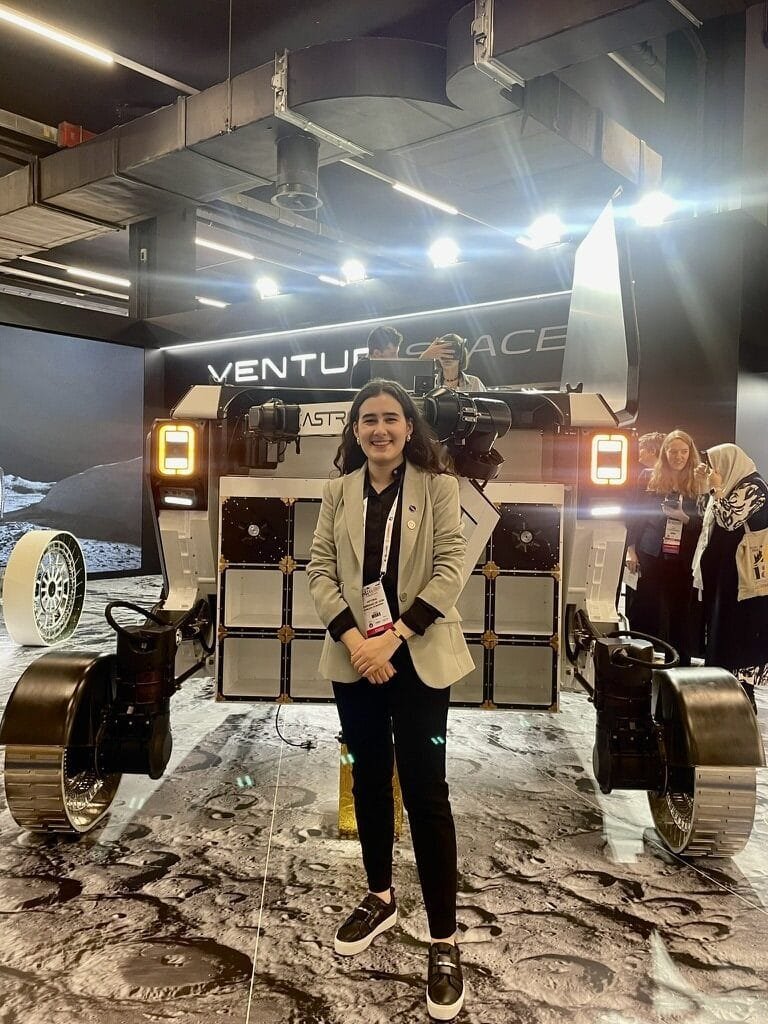Victoria de León, a student at the Monterrey Institute of Technology, has developed a Mexican innovation in lunar exploration that could enhance the safety and sustainability of missions. Radiation has always been a critical challenge in lunar missions, threatening astronaut’s health with risks such as skin cancer. This advancement promises to protect astronauts, but it also has potential health applications on Earth.
Key Points
- Victoria de León is the first Mexican recognized at the International Astronautical Congress.
- Her project consists of a mat that detects radiation and damage from micrometeorites.
- The mat glows when exposed to UV radiation, signaling the urgency to act.
- The material combines lunar regolith with biomaterials.
- Her research supports longer and more sustainable missions.
- The project is enrolled in NASA’s materials module.
- The material has potential applications in hospitals and airplanes.
Deep Dive
Mexican Innovation in Lunar Exploration
Victoria de León has created a passive chemical sensor that could change the game for lunar missions. This mat, designed for lunar habitats, acts as an indicator of radiation and structural damage. When it begins to glow, it alerts to the need to activate safety protocols.
Victoria explains: “It functions as a passive chemical sensor. I discovered how to make lunar regolith flexible and behave like a roll, and I added a biomaterial that glows under UV light.“
The Impact of Radiation on Space Exploration
Radiation is one of the biggest obstacles for prolonged missions on the Moon. According to the Mexican Skin Cancer Foundation, exposure increases at higher altitudes, making it crucial to find effective solutions. Victoria’s project tackles this issue while promoting efficient resource use on the Moon, decreasing dependency on Earth materials. As Victoria notes, “Radiation is the main long-term problem on the Moon; taking care of astronauts’ health is the most complicated.”
How it works
Victoria de León has created a passive chemical sensor that could change the game for lunar missions. This mat, designed for lunar habitats, acts as an indicator of radiation and structural damage. When it begins to glow, it alerts to the need to activate safety protocols.
The material designed by Victoria de León is an innovative system for detecting radiation and structural damage, intended for use in lunar habitats. It works in a simple but effective way:
- Base Material: It is made with lunar regolith, which is the dust and rocks that cover the Moon’s surface. This base easily adapts to the lunar environment.
- Integrated Biomaterial: A special biomaterial that glows when exposed to ultraviolet (UV) radiation has been incorporated.
- Radiation Detection: When the mat detects dangerous levels of radiation, it begins to glow. This glow acts as a warning signal for astronauts, indicating they must take immediate action.
- Damage Indication: In addition to detecting radiation, the mat can indicate damage caused by micrometeorites, small space fragments that can impact and damage lunar structures.
- Safety Protocol: The mat’s glow activates safety protocols, including evacuating the affected area and taking necessary repair actions.
This system allows astronauts to live and work on the Moon more safely by providing them with a reliable tool to monitor their environment and react to potential dangers.
Applications on Earth, Inspiration from Space
This type of mat can be placed inside lunar habitats; it could serve as a parameter for measuring received radiation as well as degradation and formation of cracks due to the constant impact of micrometeorites.
The innovative material developed by Victoria de León also has practical applications on our planet. Exposure to radiation is greater at high altitudes, which increases the risk of developing skin cancer. This reality underscores the importance of having systems that can detect and alert about dangerous levels of radiation.
Victoria plans to explore the use of her material in various terrestrial environments:
- Hospitals: It could be used in areas with high radiation exposure, providing a visual alert system to protect both patients and medical staff.
- Airplanes: In the airborne environment, where exposure to cosmic radiation is a concern, this material could offer an additional method for monitoring and managing radiation levels.
This approach not only reinforces the importance of space innovations for Earth but also demonstrates how these solutions can contribute to improving safety and well-being in our daily lives.
Victoria comments: “My next step is to explore it in hospitals where there is high radiation exposure, or it could be used in airplanes.”
Conclusion
Victoria de León’s work is an inspiring example of how innovation and ingenuity can open new possibilities in space exploration and beyond. Her project not only promises to improve the safety of lunar missions but could also have a significant impact across various industries on Earth. For those interested in the future of space exploration and its applications on our planet, this development deserves attention. As Victoria concludes, “Thinking about the Moon really leads you to innovate on Earth.”
References
- Loo, E. S. (n.d.). Victoria en Milán: alumna Tec, 1era. mexicana en ganar premio espacial. Tecnológico De Monterrey. https://conecta.tec.mx/es/noticias/ciudad-de-mexico/salud/victoria-en-milan-alumna-tec-1a-mexicana-en-ganar-premio-espacial
Glossary
- Biomaterial: A material derived from living organisms or designed to imitate their properties, often used in medical applications or sustainable products.
- Exposure: The state of being in contact with something, such as radiation or light, which can potentially cause harm.
- Micrometeorites: Tiny particles of dust or rock from space that can collide with celestial bodies like the Moon or spacecraft.
- Protocol: A set of rules and procedures to follow in dangerous situations, providing instructions for safety measures.
- Radiation: Energy transmitted in the form of waves or particles, which can be harmful in high doses, affecting living tissues.
- Radiation: A type of radiation from the sun that can be harmful, capable of causing skin burns and other health issues with prolonged exposure.
- Lunar regolith: The layer of dust and broken rock that covers the surface of the Moon, composed of fine particles and small stones.


